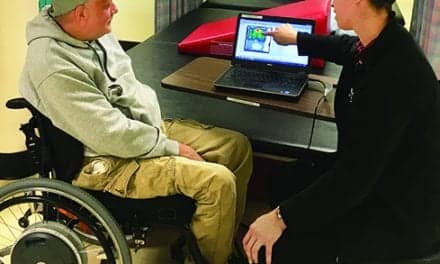How customized wheelchair seating and positioning can impact the body’s function and performance.
by Kirsten Davin, OTD, OTR/L, ATP, SMS
The impact of customized wheelchair seating on the user’s ability to participate in daily activities and be as independent as possible from wheelchair level is immeasurable. This likely comes as no surprise, as an abundance of literature is available discussing the relationship between wheelchair seating and positioning and activities of daily living. While daily function is an important component to our roles and responsibilities, a more intimate—and often overlooked—outcome of proper wheelchair seating and positioning is the impact it has upon the body’s physiological performance.
The customized wheelchair seating arena includes a variety of high- and low-tech options. Low-tech seating options may include products that consist of foam-in-place fabrication or manufactured custom-contoured seating components, while high-tech seating options may incorporate digital imagery and pressure mapping technologies to map the wheelchair user’s anatomy to ensure as accurate of a fit as possible.
While the advancements in technology and the availability of products related to wheelchair seating and positioning have expanded in recent years, a challenge that has paralleled this development is the ability of the therapist or equipment supplier to remain abreast of the plethora of custom seating options available as well as determine the most preferred custom seating options for the client.
Addressing Asymmetries in Customized Wheelchair Seating
When considering the application of customized wheelchair seating options or complex seating, therapists must address client asymmetries as related to posture and positioning. Clients may present with asymmetries that are either correctable or non-correctable. A correctable asymmetry presents when a client’s asymmetry is able to be returned to a neutral and hopefully improved functional position, while a non-correctable asymmetry occurs when the client’s asymmetry is fixed or unable to be adjusted. In many cases, there isn’t a clear correctable or non-correctable asymmetry, as often, clients may present with an asymmetry that is correctable to a point, then non-correctable as the return to midline nears. The ability to delineate between the two classifications of asymmetries is imperative, as the type of asymmetry present—correctable or non-correctable—will determine the course of action in the development and application of custom seating.
It is often easy to see the functional improvements that accompany improved seating and positioning as a result of the implementation of custom seating. It is sometimes more difficult to identify the physiological outcomes. Let’s take a look at the following physiological outcomes as they relate to seating and positioning.
Respiratory Performance and Pulmonary Capacity
Consider a time when you were in a sitting position. If you allow your pelvis to tilt to the back of the chair, demonstrating posterior pelvic tilt, your torso will subsequently be positioning in a forward flexed position. If this posterior pelvic tilt is aggressive or combined with trunk or core weakness, this could impact the diaphragm and compromise your respiratory performance or pulmonary capacity over time.
If this occurs within a wheelchair’s seating system, often a physical or occupational therapist may recommend the use of an accessory device for use on the wheelchair, such as a pelvic support or anterior trunk support to position the trunk in as neutral or functional of a position as possible. Improved trunk neutrality will usually be demonstrated by an improvement in respiratory performance. Sometimes a therapist can identify this visually, while other times you’ll need to use a pulse oximeter or other pulmonary testing to indicate improvement.
Head and Trunk Control for Eye Gaze
In the example above, following intervention to support the torso, many clients will experience improved head control, resulting in improved eye gaze. Other times, clients may require additional product application to provide the necessary support to the head, such as an anterior head support to prevent the head from resting in a forward flexed position. If adequate head and trunk control is able to be achieved, the client’s eyes will be in direct, or improved, line of sight to objects used in activities of daily living, paths of mobility, and for social engagement.
Imagine how difficult it would be to have a conversation with someone across the table from you if your head was in a forward flexed position (ie, chin to chest). Proper head and trunk control in conjunction with the client’s customized wheelchair seating systems are essential to promoting a neutral and functional eye gaze. This is especially important for clients who are self-propelling their wheelchair or for those using powered mobility.
Digestive Performance and Swallow
Forward flexion of the trunk as a result of posterior pelvic tilt or an ill-fitting seating system, as noted above, can also have a negative impact on one’s digestive performance. Research suggests a poor sitting posture can put unnecessary stress on the digestive system and lead to digestion issues such as stomach acid imbalance, malabsorption of nutrients, and irritable bowel syndrome. Proper pelvic positioning and torso alignment can encourage proper digestive and bowel health.
Proper cervical and torso positioning promotes a functional swallow in accompaniment with the digestive performance noted above. Consider, for example, a client who presents in the wheelchair seating system with a positioning system that places the neck in slight extension. This extended position can hinder the user’s swallow capabilities and create a significant risk for aspiration in some clients. Positioning that considers the client’s positioning needs for an effective swallow can help to reduce the risk of aspiration, which could lead to pneumonia and other respiratory concerns.
Skin Protection and Breakdown Prevention
When asymmetry is present within a seating and positioning system, the risk of uneven pressure distribution, leading to skin breakdown and pressure injury, is immense. A client who presents with pelvic obliquity holds a significant chance of experiencing pressure-related skin breakdown to the ischial tuberosity under the low side of the pelvis. And a client who presents with posterior pelvic tilt, often with accompanying forward flexion of the trunk, runs the risk of skin breakdown to the sacral or coccyx region. Use of an adjustable wheelchair cushion with pelvic height adjustability can help neutralize the pelvis in cases of a correctable pelvic obliquity and accommodate in cases of non-correctable pelvic obliquity to circumvent pressure injuries, prevent skin breakdown, and avoid the risk of complications such as infection, sepsis, and more.
Current Asymmetries and Deformities
The abundance of seating and positioning options available can aid in slowing or preventing the progression of asymmetries a client may currently present with. If the client presents with correctable lateral flexion of the trunk along with a pelvic obliquity, using an obliquity cushion along with lateral supports as needed can assist in correcting the current asymmetry and prevent further progression of the issue.
If the client did not receive any intervention, it is likely that the pelvic obliquity would continue to progress and pull the lateral flexion along with it, creating a greater asymmetry and, over time, increasing the chance of the asymmetry’s transition to a non-correctable issue. This would likely result in greater issues as well, including skin integrity concerns, respiratory or pulmonary ramifications, and more.
The best time to attempt to correct and address asymmetries or deformities is immediately following the identification of the concern. Quick identification and early, effective intervention offers the best opportunity for the best outcomes.
Muscle Tone
Altered muscle tone is an issue commonly identified during the seating and evaluation process. Altered muscle tone, either in terms of hypotonicity, which is a presentation of low tone, or hypertonicity, which is a presentation of elevated tone, can limit the user’s independence in the performance of functional tasks, and affect the way a user interacts with their wheelchair equipment.
Hypotonia—often presenting as a symptom in cerebral palsy, muscular dystrophy, or spinal muscular atrophy—can render the wheelchair user unable to hold an upright, functionally independent position when seated. Wheelchair cushions with increased contouring or use of laterals, hip guides, medial supports, and more may assist with maintaining independence in clients with hypotonia and address or improve other physiological considerations noted above. A tilt-in-space feature on either a manual or power wheelchair base can also assist users with hypotonicity by allowing gravity to assist in maintaining stability of the trunk.
Hypertonicity—common in cases of cerebral palsy or with clients who have experienced acquired brain injury—presents as increased muscle tone, with joints in the arms and legs that are quite difficult to flex or extend. To better support the trunk and subsequently improve other physiological functions, therapists may recommend using wheelchair cushions that can accommodate the change in positioning as well as back supports that present with wrap-around contour or lateral thoracic supports.
Upper Extremity Function and Performance of Daily Living Tasks
An effective seating and positioning system will not only promote proper physiological function such as swallow, digestive, and respiratory performance, but also allow for upper extremity movement and function. They can thus enhance the user’s performance in activities of daily living, which support physiological function, mental health, and well-being as well as allow the client to perform exercise tasks. Encouraging exercise and movement, in turn, can help to improve and maintain other aspects of physiological function such as respiratory performance and pulmonary capacity.
In short, the wide-reaching goal and overall objective of wheelchair seating and positioning is to assist the user in acquiring as neutral and as functional of a position as possible in order to promote the highest capabilities in function. In addition to promoting function, the seating system should aim to protect skin integrity and address other physiological considerations, as clients’ effective physiological function is paramount to their health and well-being. RM
Kirsten Davin, OTD, OTR/L, ATP, SMS, an occupational therapist of nearly 20 years and expert in the seating/positioning industry, currently serves as a clinical assistant professor and academic fieldwork coordinator for Baylor University’s OT Doctorate Program. For more information, contact [email protected].
PHOTO CAPTION: Anterior support accessories may be used to encourage a neutral trunk, resulting in improved respiratory performance. Photo: Kirsten Davin





